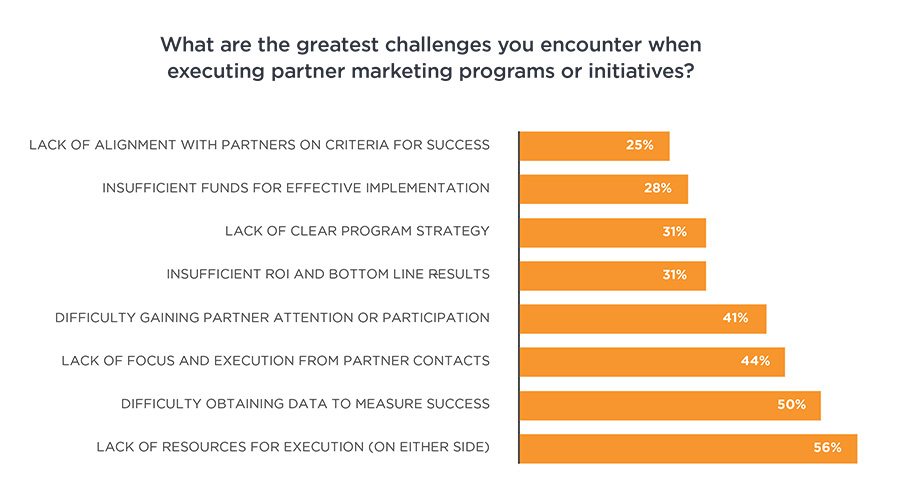SHARE

Summary and Takeaways
To overcome key challenges, partner marketing and channel marketing teams from B2B vendors should follow these four guidelines:
- Define clear priorities and invest in them.
- Listen to your partners, understand their needs.
- Improve the digital experience for your partners.
- Invest in your partner portal or platform.
Read on for the full details.

Are You Fighting for the Attention of Your Channel Partners?
Channel partners are an essential revenue source for B2B brands. Organizations rely on these partners, from value-added resellers (VARs) and distributors to system integrators, to get their products and solutions into customers’ hands. That effort typically requires extensive marketing support from vendors to partners, who need ready-to-go campaigns, training, and other support to reach target audiences.
As more B2B brands compete for the attention of channel partners, however, providing a best-in-class channel marketing program (also known as “partner marketing”— the terms are used interchangeably here) becomes more challenging and more critical. The most successful organizations understand how to navigate channel marketing challenges.
Top Channel Marketing Challenges in 2022
Vendor partner marketing teams report three top challenges when executing partner marketing programs and initiatives, according to Tendo Communications’ B2B Partner Marketing Insights 2022 report.

- Lack of resources for execution: 56% of surveyed partner marketers cited a lack of resources as their #1 challenge. Even though partner companies drive the majority of revenue at many B2B companies, channel marketing is traditionally underinvested compared to customer-facing marketing programs. Vendor partner marketing teams with limited budgets and headcounts must make difficult, strategic choices about how to allocate resources. They must help all partners but also find ways to deliver greater support to the most engaged partners and those best positioned to advance their business goals.
Another reality makes channel marketing even more challenging and resource-intensive than other marketing disciplines: Vendor marketers must engage and support different personas (marketers, sellers, admins, etc.) as well as different company types—VARs, distributors, managed service providers—who engage and transact in very different ways. This complex ecosystem makes delivering a personalized or tailored experience increasingly difficult. - Difficulty obtaining data to measure success: Wrangling data from partners is the top challenge for 94% of decisionmakers in charge of partner marketing campaigns and content and for 60% of leaders who oversee partner communication and relationship management. They commonly struggle with tracking ROI and revenue attribution. Data can be difficult to extract from partner portals and platforms or, worse, must be chased down manually from dozens of partners.
- Difficulty gaining partner attention: Too many partners do not engage with communications and others simply do not participate consistently in vendors’ partner programs. Some partner teams are stretched too thin with multiple vendors competing for their attention and participation in separate programs. Other partners express frustration at vendor programs that are too complex and time-consuming—or constantly changing.
4 Guidelines for Channel and Partner Marketers
Tendo Communications has supported numerous partner marketing teams over the years and seen firsthand how they grapple with these challenges. In our experience, successful vendors follow these four guidelines:
- Define clear priorities and invest in them.
- Listen to your partners, understand their needs.
- Improve the digital experience for your partners.
- Invest in your partner portal or platform.
Define Clear Priorities and Invest in Them
A lack of resources is magnified when your partner marketing team has too many competing priorities. Your marketing plan contains too many strategies and tactics, and not enough budget or staff to implement them properly. Partner marketing team leaders: It’s on you to make the tough choices and define the top priorities, then execute them well.
One more best practice: Articulate your partner marketing strategy in a formal plan with actionable details. According to IDG’s 2020 Partner Marketing Study, 85% of organizations that have a documented strategy say their partner marketing efforts provide good to great value.
Listen to Your Partners, Understand Their Needs
When was the last time you asked your partners about what they need to be truly successful with your product/service/brand? Learn their pain points and resolve them.
“It’s too easy to design a partner program around your own objectives and the needs of internal business silos,” says Zach Edling, Vice President of Account Services at Tendo Communications. “Align it with your partners’ business objectives, and you’ll increase participation and grow revenue.”
Identify your partners’ pain points when developing your program. Those challenges can vary widely: their sales teams don’t fully understand your product or service’s value proposition, or their marketers don’t find your content and campaigns useful enough.
Then go a step further: Uncover the “top tasks” that partners want to complete when they visit your partner site and engage with your brand. These are the specific educational and transactional tasks they want to accomplish—from accessing certification trainings and downloading content assets to registering a deal. Map out their steps and determine where they stumble, and from there you can learn what to do to help them complete their top tasks more frequently and easily.
Improve the Digital Experience for Your Partners
You already focus on creating superb digital experiences for your customers—now do the same for your partners. In short, make it easier for partners to participate in your program. A better digital experience means they find what they need quickly and effortlessly. They read your emails and attend your webinars because you’re focused on their needs and you provide genuine value.
With the insights you gathered on partners’ top tasks and priorities, you can optimize your partner portal or website to improve their digital experience. As partners engage with your resources more often, they’ll become more adept at selling and positioning your solutions and products and transact with you more often.
Invest in Your Partner Portal or Platform
To create a better digital experience to partners, you must invest in ongoing improvements to your digital platform. Your partners’ needs should influence – if not steer – your priorities. Platform enhancements could include improvements to reporting and tracking capabilities, adding interactive trainings, or giving partners access to email automation or account-based marketing tools.
“Investments in partner portals deliver a strong ROI,” says Edling. “Improving your platform should be a top priority in 2022.”

View the Full Report
For deeper insights into channel marketing challenges, successes and priorities, download Tendo’s report, B2B Partner Marketing Insights 2022.
To learn more about how Tendo Communications can help your partner marketing program succeed, contact us today.
Subscribe for Content Strategy Trends and Guidance
Get our monthly e-newsletter with Tendo’s latest thought leadership and content resources for B2B leaders.




